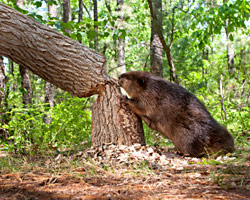Beaver Removal and Control
Beavers…Beneficial, but Destructive. Beavers are the largest aquatic rodent in North America and are abundant in our streams, ponds, lakes and wetlands. They feed on a variety of vegetation, but prefer soft wood trees. They build lodges in which to live near water’s edge or in the water body.
The dams they construct from their tree-cutting activities are ecologically friendly to fish and other wildlife, but the dams can also cause flooding to nearby agricultural areas, roadways, and residential areas. Some beavers burrow into the banks of bodies of water, which can cause collapses during high water. Their eating habits can cause damage to trees, ornamental landscaping, crops and even buildings. Half chewed trees can become a liability issue, and beavers are thought to contribute to primary and secondary waterway contamination. It is easy to see how beavers can cause human conflicts.
 About Beavers
About Beavers
Beaver weigh an average of 50 pounds and have luxurious fur and a paddle tail which they use to swim under water. Their small front feet are equipped with long, sharp nails, while the hind feet are large and webbed. Their voracious appetite is the primary cause of human threats.
If the beavers are not removed and relocated when the first signs of damage become evident, they can quickly grow in population, making them much more difficult and costly to control.
Beaver Diseases
Beavers can disseminate bacterial and parasitic diseases that humans can contract by handling the animals or carcasses, coming in contact with contaminated water, or breathing in the bacteria. Tularemia is a potentially fatal disease with flu-like symptoms that can be treated with antibiotics. Giardiasis is a diarrheal illness caused by a parasite that gets into human intestines through contact with any contaminated matter.
Professional Removal and Control of Beavers
While building fences and and barriers around culverts, drain pipes and bodies of water can help, it is often not practical, and beavers will sometimes just incorporate the structure into their dam building. Timely trapping and relocation is the most effective way of controlling beaver populations and preventing damage to the environment and property. This is a very difficult and complex task and should be left to professionals.
Service Areas
We offer beaver removal in Harrisburg, Mechanicsburg, Duncannon, Enola, Dillsburg, Carlisle, Camp Hill, New Cumberland, Lemoyne, Wormleysburg, Hershey, Marysville, Hummelstown, Steelton, Middletown, Highspire, Halifax, Dauphin and other areas within a 25 mile radius of the Harrisburg area.
We provide beaver removal in Dauphin County which includes Lower Paxton Township, Middle Paxton Township, Susquehanna Township, Derry Township, Swatara Township, Lower Swatara Township, East Hanover Township, West Hanover Township, South Hanover Township, and Londonderry Township.
We provide beaver removal in Cumberland County which includes East Pennsboro Township, Hampden Township, Lower Allen Township, Upper Allen Township, Middlesex Township, Silver Spring Township.
We provide beaver removal in Perry County which includes Rye Township, Penn Township.
We provide beaver removal in York County which includes Carrol Township, Newberry Township, Fairview Township, Monaghan Township.

 About Beavers
About Beavers